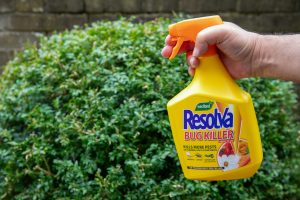Little is more satisfying in the garden than a well-grown, perfectly-trimmed Buxus (box). This popular shrub is planted in both pots and borders and can be trimmed into various shapes. Sadly, the nation’s poor box plants are currently suffering a two-pronged attack from a pair of nasty pathogens which have the potential to severely disfigure and kill even long-established plants. In many areas of the UK, gardeners are best advised to avoid planting new box in favour of other resistant species.
Here’s our handy guide on how to guard your Buxus:
Box Blight
Box blight is a disease that can be caused by a pair of closely related fungi, resulting in browning foliage, bare patches and eventually cause the plant to die back. The disease has been in the UK since the 1990s: the fungi that causes it are now found in many parts of the world. Box blight can spread locally via spores in wind-blown rain and possibly by animals. The fungi survive for more than five years, lying in wait in fallen leaves, then dispersing spores and starting an outbreak when conditions are suitable. This means that clearing up fallen box leaves is key to reducing the spread and severity of the disease. Catching box blight early makes a massive difference on the chances of managing the problem.

Buxus Feed
Buxus 2 in 1 Feed & Protect helps Buxus to retain water and acts as a soil improver to give your plants the best start. This 2-in-1 solution comprises of two bottles; the first contains a concentrated Buxus feed. This feed gives greener as well as healthier foliage. The second bottle contains minerals to enhance the plant’s natural immune system. This feed is child, pet and even bee-friendly! 
Pruning
The best time to prune Buxus is between late August and early September to reduce the risk of box blight. Use Kent and Stowe’s General Purpose Hedge Shears, making sure to sanitise the blades between each plant, to reduce the spread of possible disease. These hedge shears have non-stick carbon steel blades that give a smoother cut, whilst being lightweight and comfortable to use.
If a minor outbreak of box blight strikes in your garden, don’t panic! Immediately follow these simple steps that may control the problem:
- Firstly, cut out and bag up any diseased branches and leaves from affected plants. Sanitise your tools after use on infected plants.
- Bin this material; don’t add to the compost heap. Badly blighted individuals are best dug up and disposed of altogether.
- Next, scrape away all fallen leaves and debris around the base of your affected Buxus, removing the top layer of soil.
- Apply a mulch of garden compost then feed affected plants.
Carried out promptly, these actions can limit disease spread to other areas and your plants should re-grow.
Box Tree Moth
Box tree moth is an introduced pest from east Asia; it was first found in Europe in 2006. Since then, it has become an invasive species, and is rapidly spreading across the UK. The caterpillars are voracious feeders, able to eat through large plants in a single season.


From October onwards, the caterpillars hibernate on box plants in a small web that sticks leaves together. They overwinter and begin feeding in April, becoming moths in June. Resulting adults live for eight days, with females laying eggs on box foliage that hatch after a week. Caterpillars feed for a month, developing into more egg-laying moths from August. The year’s last young caterpillars appear in September, ready to overwinter and begin the cycle again.
While many of us don’t like to use sprays or chemicals in our gardens, you may feel there are occasions when the use of pesticides is justified. Resolva Bug Killer Ready To Use is effective against a range of caterpillars (such as box moth). This product needs to be applied carefully yet thoroughly, both outside and inside the Buxus plant when caterpillars are feeding.

Follow the instructions carefully: do not apply near flowering plants where pollinators may be active. Before spraying give plants a shake to disturb any resting insects that may otherwise be killed by the treatment. If your Buxus are in containers, consider moving into a garage or greenhouse before spraying. The problem with box moth is that applications of pesticide may be required twice a year to keep plants healthy.




